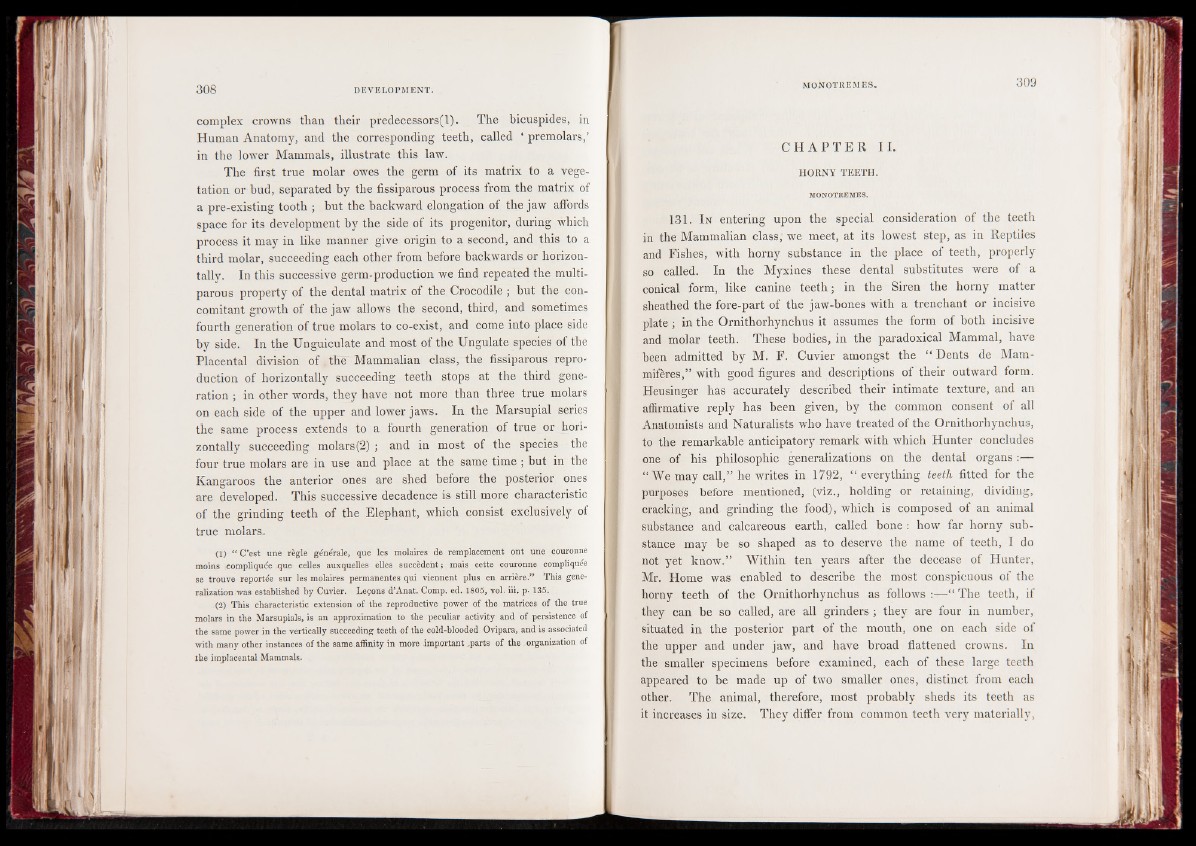
complex crowns than their predecessors(l). The bicuspides, in
Human Anatomy, and the corresponding teeth, called ‘ premolars,’
in the lower Mammals, illustrate this law.
The first true molar owes the germ of its matrix to a vegetation
or hud, separated by the fissiparous process from the matrix of
a pre-existing tooth ; but the backward elongation of the jaw affords
space for its development by the side of its progenitor, during which
process it may in like manner give origin to a second, and this to a
third molar, succeeding each other from before backwards or horizontally.
In this successive germ-production we find repeated the multiparous
property of the dental matrix of the Crocodile ; but the concomitant
growth of the jaw allows the second, third, and sometimes
fourth generation of true molars to co-exist, and come into place side
by side. In the Unguiculate and most of the Ungulate species of the
Placental division of . the Mammalian class, the fissiparous reproduction
of horizontally succeeding teeth stops at the third generation
; in other words, they have not more than three true molars
on each side of the upper and lower jaws. In the Marsupial series
the same process extends to a fourth generation of true or horizontally
succeeding molars(2) ; and in most of the species the
four true molars are in use and place at the same time ; but in the
Kangaroos the anterior ones are shed before the posterior ones
are developed. This successive decadence is still more characteristic
of the grinding teeth of the Elephant, which consist exclusively of
true molars.
(î) “ C’est une règle générale, que les molaires de remplacement ont une couronne
moins compliquée que celles auxquelles elles succèdent ; mais cette couronne compliquée
se trouve reportée sur les molaires permanentes qui viennent plus en arrière.” This generalization
was established by Cuvier. Leçons d’Anat. Comp. ed. 1805, vol. iii. p. 135.
(2) This characteristic extension of the reproductive power of the matrices of the true
molars in the Marsupials, is an approximation to the peculiar activity and of persistence of
the same power in the vertically succeeding teeth of the cold-blooded Ovipara, and is associated
with many other instances of the same affinity in more important .parts of the organization of
the implacental Mammals.
C H A P T E R I L
HORNY TEETH.
MONOTEEMES.
131. In entering upon the special consideration of the teeth
in the Mammalian class, we meet, at its lowest step, as in Reptiles
and Fishes, with horny substance in the place of teeth, properly
so called. In the Myxines these dental substitutes were of a
conical form, like canine teeth; in the Siren the horny matter
sheathed the fore-part of the jaw-bones with a trenchant or incisive
plate ; in the Ornithorhynchus it assumes the form of both incisive
and molar teeth. These bodies, in the paradoxical Mammal, have
been admitted by M. F. Cuvier amongst the “ Dents de Mammifères,”
with good figures and descriptions of their outward form.
Heusinger has accurately described their intimate texture, and an
affirmative reply has been given, by the common consent of all
Anatomists and Naturalists who have treated of the Ornithorhynchus,
to the remarkable anticipatory remark with which Hunter concludes
one of his philosophic generalizations on the dental organs :—
“ We may call,” he writes in 1792, “ everything teeth fitted for the
purposes before mentioned, (viz., holding or retaining, dividing,
cracking, and grinding the food), which is composed of an animal
substance and calcareous earth, called bone : how far horny substance
may be so shaped as to deserve the name of teeth, I do
not yet know.” Within ten years after the decease of Hunter,
Mr. Home was enabled to describe the most conspicuous of the
horny teeth of the Ornithorhynchus as follows :—“ The teeth, if
they can be so called, are all grinders ; they are four in number,
situated in the posterior part of the mouth, one on each side of
the upper and under jaw, and have broad flattened crowns. In
the smaller specimens before examined, each of these large teeth
appeared to be made up of two smaller ones, distinct from each
other. The animal, therefore, most probably sheds its teeth as
it increases in size. They differ from common teeth very materially,